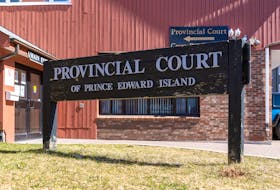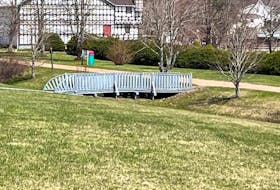For Lisa Smith the pandemic started off with a round of bad news.
By early March, it was clear that staff at Glen Haven Manor, a 202-bed long-term care facility in New Glasgow, Nova Scotia, could not take vacations. The risk of bringing the COVID-19 virus into Glen Haven was simply too great.
“To be honest, I think we cancelled 26 trips,” Smith, CEO of Glen Haven Manor, told SaltWire in an interview.

The home imposed staff restrictions by March 12, earlier than most. The cancellations were out of pure necessity. Smith needed all hands on deck and could not lose frontline workers to vacations let alone the self-isolation that would follow.
“We did not have the staff to allow them to take an extra two weeks off because, as (with) all long-term care facilities, or most across this great nation, we have a staffing crisis,” Smith said.
Glen Haven was an early adopter of many of the COVID-19 infection control practices. A COVID-19 pandemic plan was developed by March 1. By March 24, staff had set up a “Rona wing,” a separated isolation room in case residents tested positive for the virus. Staff were banned from working in other long-term care facilities and outside visits were curtailed two weeks before provincial measures restricted visits in long-term care homes.
Administrators worked out a deal with local hotels to allow staff with family who had recently returned from travel abroad to self-isolate at a discount price. Local grocery stores established private shopping hours specifically for long-term care staff. By early April, staff and residents at Glen Haven were cohorted, with each resident care area set up with their own separate entrances and change areas.
Protecting the vulnerable
So far, COVID-19 has been kept out of Glen Haven Manor. Smith wants to keep it that way.
“If you sit in a chair like this, you take it very serious.”
She explains her job in simple terms: “To protect the elderly and the most vulnerable.”
But she credited the dedication of Glen Haven staff. They got “a couple of days off” over the summer but Smith said that’s not the break they deserved in the height of the pandemic.
“They are getting tired but they still come to work every day. They still have smiles on their faces,” she said.

Many of the preventative measures adopted at Glen Haven became standard at homes in Nova Scotia and other Atlantic Provinces. With the exception of the devastating outbreak at Northwood in Halifax, these efforts appear to have kept COVID-19 in long-term care in a region with a high population of seniors.
For a different outcome, look to central Canada. The second wave of the COVID-19 pandemic has been devastating in long-term care homes in Ontario, Quebec and elsewhere. The vast majority of COVID-19 deaths across Canada have occurred in long-term care.
In Atlantic Canada, only 26 of 766 long-term care facilities have had people test positive for the virus as of late January and only 64 have died. Fifty-three were at Northwood. Nova Scotia has had 57 deaths due to the virus in long-term care while New Brunswick, as of the last week in January had seven. The mid-January outbreak at the Shannex Parkland seniors complex in Saint John, New Brunswick claimed four lives. An additional two who tested positive for COVID-19 also died in late January.
But most long-term care facilities in the region, including all in Newfoundland and Labrador and P.E.I., have avoided outbreaks.
Magnolia’s early warning
Michele Lowe, Managing Director of the Nursing Homes of Nova Scotia Association said this is because many nursing homes scrambled early on to put in place COVID-19 infection control measures.
An early outbreak of COVID-19 involving two residents and three staff members at the Magnolia Continuing Care facility in Enfield on March 29 prompted many within the sector to ramp up infection control.
“They immediately were able to identify key things that none of us were told, none of us knew about," Lowe said.
Tracey Tulloch, communications director for Rosecrest Communities, which administers Magnolia, described the week of March 29 as a “blur.”

"We instantly lost a number of staff. So we were really, really short-staffed during the height of our outbreak,” Tulloch said.
“At different points we were bare bones."
Still, the spread was contained within Magnolia. Infection control practices were strengthened to the point that a second occurrence at the facility April 23 involved only one staff member and no residents.
Tulloch attributed the containment of the outbreaks at the Magnolia to “solid nursing practices,” including heavily enforced handwashing protocols, early masking and cleaning practices. But the layout of the Magnolia allowed for residents to be cohorted within different wings, and to maintain physical distancing in hallways. The facility also had the capacity to isolate residents, as the rooms were located in “cottages,” as staff referred to them, separate from the main section of the building.
In P.E.I., several operators of long-term care facilities have attributed the lack of COVID-19 cases in long-term care to early public health measures, as well as the overal lack of community spread in the Province. P.E.I. closed off long-term care facilities to non-essential visitors on March 15, when there was only one confirmed case of the virus in the Province. At that point, only Quebec had restricted visitation.

The fear of God
Cecil Villard, executive director of the P.E.I. Association of Licensed Community Care Facilities, credited government enforcement of infection control practices, early restrictions on visitors and the monitoring of staff temperatures by administrators.
"Public health have been on top of it,” Villard said.
“The fear of God was put into this business when you consider what took place in Ontario and Quebec."
Newfoundland and Labrador Health Minister John Haggie said last May that long-term care practices were “no different” than practices in hospital wards.
Jodi Hall, executive director of the New Brunswick Association of Nursing Homes said the sector has had success in controlling infection, although she acknowledged that the Shannex Parkland outbreak occurred even though these measures were in place.
"I'm not saying we've done everything,” Hall said.
“But I think we've ultimately been successful in what the ultimate goal was, which was to keep residents safe."
New Brunswick nursing homes also put measures in place in March, before being directed by public health. They included closing non-essential visits, cancelling staff vacations and mandating masks for employees.
Newer buildings helped in New Brunswick
Hall said the comparatively newer infrastructure of nursing homes made it easier.
“We have no four-bed wards in the province. We have a higher percentage of private rooms with private washrooms, which are all critical factors in assisting in infection control," she said.
Hall also pointed to the existence of a pandemic warehouse in New Brunswick, which allowed nursing homes to access a stockpile of personal protective equipment early on. By contrast, many nursing homes in Nova Scotia complained of inadequate stockpiles of PPE for staff in the early weeks of the pandemic.

Shortages were critical
While the Atlantic region had successes in infection control during the pandemic, staff shortages are still a huge shortcoming.
In 2017, a survey commissioned by New Brunswick’s nursing home association found that a total of 3,000 staff, out a of a total of 6,500 staff in the sector, will be leaving in the next 10 years.
But the situation is already dire elsewhere.
"Fifty per cent of our members were at critical vacancy levels” last summer, said Nova Scotia association chief Lowe.
Reports released by both the Nova Scotia Nurses Union and the New Brunswick Nurses Union have called for provincial staffing standards in nursing homes to guarantee at least 4.1 resident care hours per day for each resident. The NSNU has reported that the current staff-resident ratio is 2.45 hours of care per day in Nova Scotia, while the NBNU has reported that the ratio is 2.89 hours per day in New Brunswick. P.E.I uses a different tool to measure staffing ratios.
In New Brunswick, wages aren’t the issue, NBNU’s Hall said. Nursing home wages there are on par with those within acute care in hospital settings.
What’s driving many out of the sector is the stress, says Sharon Teare, president of the New Brunswick Council of Nursing Home Unions.
"It's always been about the working conditions. So now because the working conditions have reached a point of crisis, the burn-out and the turnover rate is like it's never been before," she said.
The isolation, compounded by restrictions on visitors, has taken a toll on the mental health of many residents. Teare, who also works at a nursing home in Saint John, described the difficult situation many workers face when explaining to long-term care residents why their family cannot visit them.
“The most heartbreaking thing that's happened here recently is when a resident looked at me, held my shoulders and said 'I would just rather die than live like this.'" Teare said.
"That's not what we should be providing for our seniors."








